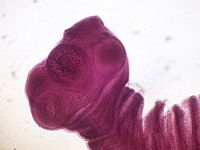
Photo from wikipedia
Larvae of the cestodes Taenia solium and Taenia crassiceps infect the central nervous system of humans. Taenia solium larvae in the brain cause neurocysticercosis, the leading cause of adult-acquired epilepsy… Click to show full abstract
Larvae of the cestodes Taenia solium and Taenia crassiceps infect the central nervous system of humans. Taenia solium larvae in the brain cause neurocysticercosis, the leading cause of adult-acquired epilepsy worldwide. Relatively little is understood about how cestode-derived products modulate host neural and immune signalling. Acetylcholinesterases, a class of enzyme that breaks down acetylcholine, are produced by a host of parasitic worms to aid their survival in the host. Acetylcholine is an important signalling molecule in both the human nervous and immune systems, with powerful modulatory effects on the excitability of cortical networks. Therefore, it is important to establish whether cestode derived acetylcholinesterases may alter host neuronal cholinergic signalling. Here we make use of multiple techniques to profile acetylcholinesterase activity in different extracts of both Taenia crassiceps and Taenia solium larvae. We find that the larvae of both species contain substantial acetylcholinesterase activity. However, acetylcholinesterase activity is lower in Taenia solium as compared to Taenia crassiceps larvae. Further, whilst we observed acetylcholinesterase activity in all fractions of Taenia crassiceps larvae, including on the membrane surface and in the excreted/secreted extracts, we could not identify acetylcholinesterases on the membrane surface or in the excreted/secreted extracts of Taenia solium larvae. Bioinformatic analysis revealed conservation of the functional protein domains in the Taenia solium acetylcholinesterases, when compared to the homologous human sequence. Finally, using whole-cell patch clamp recordings in rat hippocampal brain slice cultures, we demonstrate that Taenia larval derived acetylcholinesterases can break down acetylcholine at a concentration which induces changes in neuronal signalling. Together, these findings highlight the possibility that Taenia larval acetylcholinesterases can interfere with cholinergic signalling in the host, potentially contributing to pathogenesis in neurocysticercosis.
Journal Title: PLoS Neglected Tropical Diseases
Year Published: 2020
Link to full text (if available)
Share on Social Media: Sign Up to like & get
recommendations!